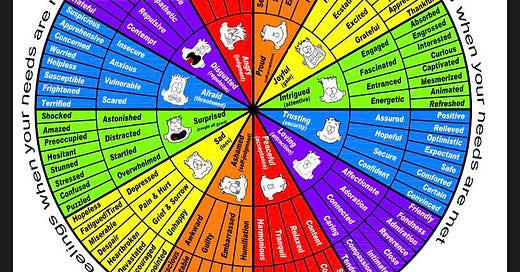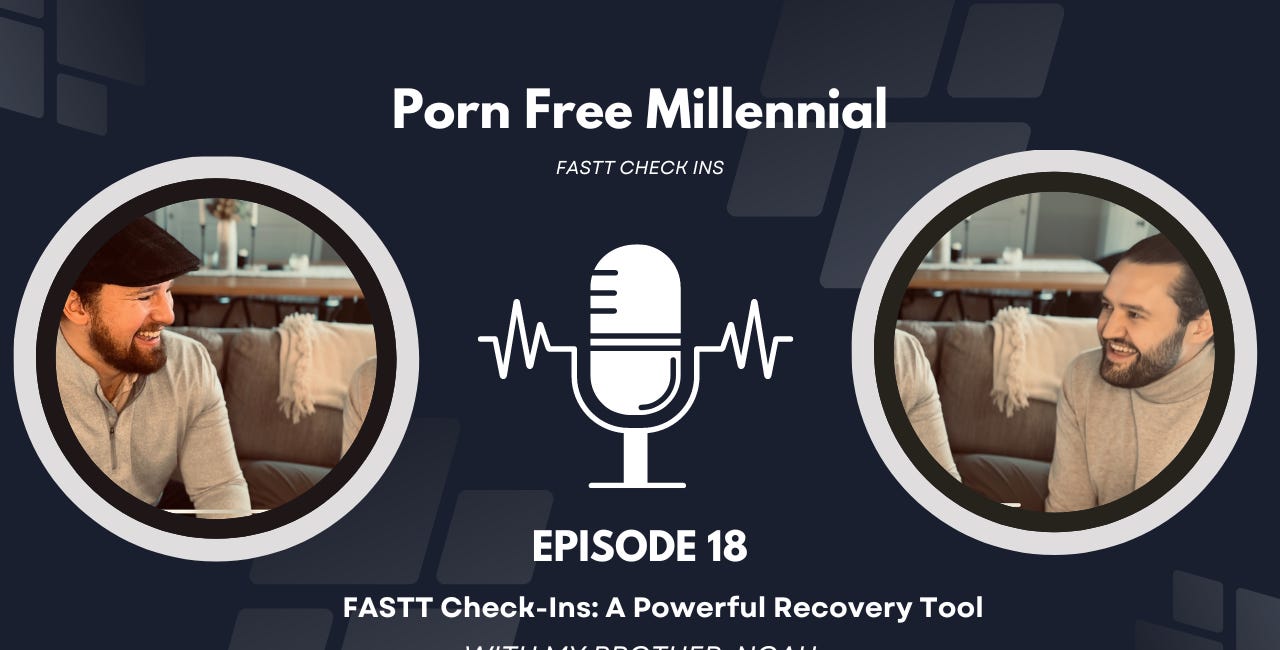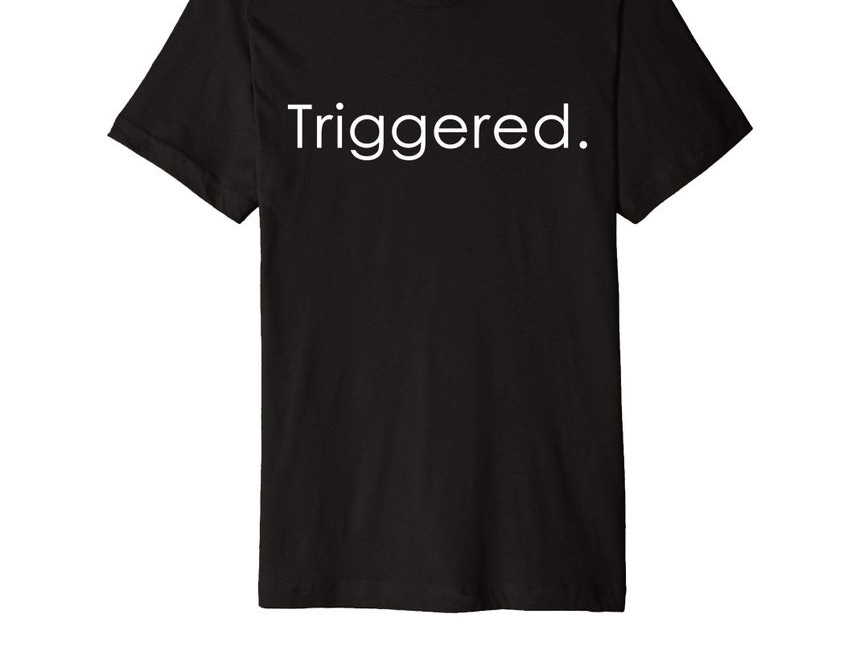This yearlong weekly journey is designed to help you break free from what I call the porn prison - a state of mental, emotional, and spiritual confinement caused by porn consumption. This prison traps individuals in cycles of shame, isolation, and disconnection, making it difficult to live a life of purpose and fulfillment.
Each Friday for the full year of 2025, I’ll dive into a key aspect of recovery, provide practical tools, and challenge you to take meaningful steps toward lasting freedom. Whether you’re just starting your journey or already working toward healing, this series offers encouragement, clarity, and structure to help you build and sustain a new, liberated identity.
A Daily Tool for Recovery: The Power of FASTT Check-Ins
I want to share a powerful daily tool that has been essential to my recovery from problematic porn use, something I’ve used on almost daily with my little brother for the past two years. This practice has been a game-changer for my growth, accountability, and mental clarity, and I truly believe it can benefit you as well.
This tool is called a FASTT check-in. FASTT is an acronym (which I’ll break down in a moment), and I first discovered it through Matt Dobschuetz, the host of the Porn Free Radio podcast, one of my biggest inspirations in writing and podcasting about this journey.
The FASTT check-in method was developed by Dr. Milton S. Magness, a licensed professional counselor and certified sex addiction therapist. He introduced this tool to aid sex addicts and their partners in maintaining open communication and accountability during recovery.
The FASTT acronym stands for Feelings, Activities in Recovery, Sobriety (or Slip) Report, Threats, and Tools. This structured approach facilitates regular, honest check-ins, fostering transparency and mutual support. Dr. Magness details this method in his book Stop Sex Addiction: Real Hope, True Freedom for Sex Addicts and Partners.
In this article, I will explain what FASTT stands for in more detail and how to effectively incorporate it into your daily life. Each letter represents a crucial component of self-reflection and accountability, whether you’re doing this check-in alone or with a trusted partner.
18. FASTT Check-Ins: A Powerful Recovery Tool - With My Brother, Noah
In this episode, my brother and I discuss the FASTT Check-In method that is an incredible accountability tool that you can use on a daily basis for porn use recovery (or other forms of healing and self-development). This method was initially developed by Dr. Milton Magness for sex addicts and their partners, but can be applied to many areas of life. Thi…
Breaking Down FASTT
F – Feelings
Your emotions set the tone for your check-in. How are you feeling? Identifying your internal emotional state helps you recognize patterns in your behavior and what might be influencing your decisions. Credit to my mentor, Vern Tompke - Host of the Finding Traction podcast, for providing an insightful breakdown of how emotions connect with unmet or fulfilled needs.
Being honest about your emotions is key. Are you stressed, lonely, tired, anxious, or feeling strong and content? Acknowledging these feelings creates self-awareness, which is crucial in recovery. Often, emotions act as signals that point to deeper issues → perhaps stress from work, unresolved conflicts, or feelings of isolation.
The ability to pin-point your emotional state and what is connected to it will lead to a better understanding of your thoughts, actions, and your momentum → either heading north or heading south.
By developing emotional intelligence and learning to manage feelings constructively, you strengthen your ability to stay on the path of recovery and avoid impulsive behaviors driven by unchecked emotions.
A – Actions in Recovery
These are the proactive steps you take to build a stronger foundation for yourself. What actions have you committed to that support your recovery? Healthy habits require consistency to take root—research suggests it can take 1-3 months to solidify them. Here are some examples:
Getting 7-8+ hours of sleep per night – Sleep is foundational for mental clarity, emotional regulation, and overall well-being. Lack of sleep can make you more vulnerable to stress, temptation, and poor decision-making.
Exercising or taking daily walks outside – Physical activity not only strengthens your body but also helps manage stress and regulate mood. A consistent exercise routine can significantly improve your mental health and reduce urges.
Eating nutritious food – A balanced diet fuels your brain and body, helping you maintain stable energy levels. Reducing processed foods and sugar can prevent energy crashes that might lead to unhealthy coping mechanisms.
Reducing screen time and social media use – Excessive screen time can contribute to overstimulation, anxiety, and exposure to triggers. Being intentional about your digital consumption can help you reclaim focus and discipline.
Engaging in personal development (reading, journaling, prayer, etc.) – Activities that foster self-reflection and spiritual growth can reframe your mindset and provide deeper fulfillment beyond fleeting temptations.
Spending quality time with family, friends, or a partner – Healthy relationships and social connection are vital in breaking cycles of isolation and loneliness, which often fuel addictive behaviors.
By focusing on these positive actions, you’re replacing destructive habits with life-giving ones.
As I have progressed in my development, actions in recovery have morphed more into Essential Activities in Recovery and there are four pillars:
Spiritual Health – This includes engaging in practices that nurture your faith and deeper purpose. Prayer, meditation, attending church, studying scripture, or engaging in faith-based community activities all contribute to a stronger spiritual foundation.
Physical Health – Prioritizing your body's well-being through proper nutrition, exercise, and rest ensures that you maintain energy and mental clarity. A strong body supports a strong mind, which is crucial in maintaining recovery.
Relationships – Recovery is not meant to be a solo journey. Investing in healthy, meaningful connections with family, friends, mentors, and accountability partners fosters emotional stability and combats isolation.
Passions – Finding and pursuing interests that bring fulfillment and joy → such as hobbies, creative outlets, or volunteer work → helps shift focus away from destructive behaviors and toward building a purpose-driven life.
In the podcast below I talk about these more in detail. These are activities that will become a part of your identity as you invest in healthy actions in recovery, as explained above.
29. The Core Four: Essential Activities for Recovery
In this episode, we dive into the 4 Core Activities for Recovery that serve as the foundation for lasting freedom and personal growth.
S – Slips & Sobriety
Transparency is crucial in this step. You need to be open about whether you’ve crossed any personal boundaries.
Slips: These are yellow-light moments, caution signs. Maybe you spent too much time on your phone, browsed social media searching for provocative images, or entertained sexual thoughts longer than you should have. This stage is often referred to as edging, dancing too close to the line without technically crossing it. Other slips include:
Lying to yourself or your accountability partner about questionable behavior.
Objectifying or sexualizing someone in your mind.
Testing your willpower by visiting triggering sites.
Preoccupation with sexual thoughts that interfere with daily life.
Recognizing slips early is crucial because they often precede a full relapse. Slips provide an opportunity to course-correct before hitting the red-light zone.
Sobriety: This is the red light, the point of no return. Everyone’s line is different, but for me, this means no pornography in any form and no masturbation. Be honest with yourself: what are the behaviors that send you down the dark rabbit hole and leave you feeling ashamed or defeated? Identify them and draw a firm boundary. Some key ways to safeguard your sobriety include:
Establishing clear personal rules – Define what sobriety looks like for you and hold yourself accountable.
Having an accountability partner – Regular check-ins with someone who genuinely cares about your growth can be a powerful deterrent against relapse.
Replacing bad habits with good ones – Engaging in hobbies, exercise, or creative pursuits can redirect your energy positively.
Practicing self-compassion – If you slip or relapse, acknowledge it, learn from it, and refocus. Avoiding shame cycles is key to long-term recovery.
Recovery is a journey, not a straight path. You will stumble, and that’s okay. The goal is to learn from each slip, not wallow in shame. As Matt Dobschuetz often quotes from Samuel Beckett: “Try again. Fail again. Fail better.”
If you just relapsed recently, this is a podcast I recorded a month or so after my last relapse, I think it can serve as a motivating and encouraging message.
T – Threats to Recovery
These are potential triggers that could lead you to compromise your progress. The more you anticipate and acknowledge them, the better you can manage them. Triggers can be unique to each person and might seem small, but calling them out gives you power over them.
Examples of threats include:
Lack of sleep (leading to poor judgment and increased temptation)
Neglecting self-care (skipping workouts, unhealthy eating, excessive phone use)
Stressful or emotional situations (arguments, disappointments, loneliness)
Difficult conversations or relationship struggles
Preoccupation with sexually triggering content (media, social media, memories, etc.)
Even the smallest things can be triggers, so don’t dismiss them. My brother and I often joke about checking in over ridiculous things (even oddly shaped mountain peaks!), but it’s this honesty and self-awareness that keeps us on track.
For more on Triggers, check out week 4 of 52 weeks of Freedom:
Identifying Your Triggers
This yearlong weekly journey is designed to help you break free from what I call the porn prison - a state of mental, emotional, and spiritual confinement caused by porn consumption. This prison traps individuals in cycles of shame, isolation, and disconnection, making it difficult to live a life of purpose and fulfillment.
T – Tools to Combat Those Threats
You need practical, actionable strategies to counteract triggers and stay on course. A plan is only as strong as the tools you use to execute it. Here are some that have worked for me:
Physical Barriers
If your phone is a problem at night, put it in another room.
Use a locking timer box on Amazon for high-risk times.
Keep your laptop in a shared space instead of isolated areas.
Accountability Software
CovenantEyes – Blocks explicit content and sends reports to accountability partners.
Accountable2U – Tracks activity and provides real-time alerts.
Bark – A great option if you're also managing online safety for kids.
Ad-Blockers & Content Filters
AdGuard – Blocks intrusive ads and explicit content.
Pluckeye – An extreme but effective tool that lets you customize online access.
CleanBrowsing – DNS filtering to block problematic sites at the network level.
Social Media Detox
Take a break from triggering apps or set time limits.
Use One Sec to delay access and create friction.
Install StayFocusd to limit time on distracting websites.
Unfollow or mute accounts that contribute to temptation.
Phone Curfews & Digital Boundaries
Set a strict time to put devices away each night.
Use Screen Time on iOS or Digital Wellbeing on Android to enforce limits.
Switch to grayscale mode to reduce screen appeal.
Reward & Consequence Systems
Tie incentives to staying on track. Example: Treat yourself to a hobby or reward on Amazon after X days clean.
Establish consequences. Example: For each slip-up, donate to a cause you dislike via DonorSee or do extra workouts.
Consider an accountability deposit → give a trusted friend money that you only get back if you stick to your plan.
Tools Only Work If You Use Them
A tool in your pocket won’t help → you have to wield it. Consistency is key. Set up automations and rules ahead of time so you're not relying on willpower in the moment.
For more on Tools, check out Week 2 of 52 Weeks of Freedom:
Lessons from The Count of Monte Cristo | Assembling the Proper Recovery Tools to Escape the Porn Prison and Reclaim Your Life
Welcome to the 52 Weeks of Freedom Series
How to Perform a FASTT Check-In
FASTT check-ins are most effective when done in partnership with someone else. While you can do them individually, accountability makes the process far more impactful.
Methods of check-ins:
Phone calls
Voice memos - What I do with my brother.
Emails
FaceTime/Zoom - What I do with my mentor/recovery groups and therapist.
In-person meetings
Frequency options:
Daily - What I do with my brother and has been the most effective for me
Every other day
Weekly - What I do with my mentor and recovery group.
Monthly - What I do with my therapist.
I highly recommend starting with a mentor, someone you respect and don’t want to let down. Being in an echo chamber of people who enable poor habits can be harmful. Choose an accountability partner who is serious about growth and can provide real feedback.
Why FASTT Check-Ins Matter
There have been moments where I almost lost all my progress. False feelings of failure and shame tried to drag me down. But my FASTT check-ins became my lifeline.
And over time, I realized something important:
It’s not just about me anymore.
It’s about the community I’ve built → my brother, my mentor, my recovery group brothers, my therapist.
It’s about becoming a better person.
It’s about redemption.
It’s about triumph.
If you’re serious about recovery, I challenge you to start implementing FASTT check-ins today. The journey isn’t easy, but you don’t have to walk it alone. Find your people. Build your system. Stay accountable.
And most importantly, keep moving forward.
This Week’s Challenge
Keep reading with a 7-day free trial
Subscribe to Porn Free Millennial to keep reading this post and get 7 days of free access to the full post archives.











